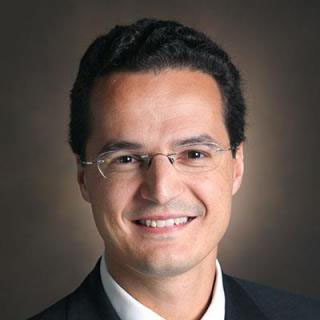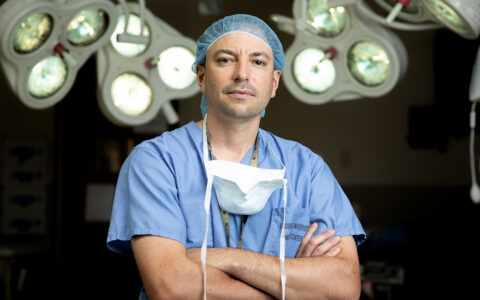Septal perforation repair has had a highly varied success rate, leaving many surgeons and patients dissatisfied with outcomes. While closing the septal perforation is fairly readily accomplished, resolving symptoms remains more elusive. Additionally, there may be negative consequences to distorting and displacing tissues borrowed or extended from other parts of the nasal passages.
“When I came to Vanderbilt, I was asked to do all the septal perforation repairs, something I didn’t relish because of the difficulty of the procedure and lower success rates. I was determined to find a different way to solve the problem,” said Scott Stephan, M.D., a facial plastic surgeon at Vanderbilt University Medical Center. Stephan has developed a new technique for septal perforation repair using bioabsorbable scaffolding and a tissue flap from the scalp.
Stephan recently published a study of the new technique in JAMA Facial Plastic Surgery. Justin Morse, M.D., also of Vanderbilt, was the first author on the study. Their research shows that the new technique – suturing a tissue graft to a scaffold and allowing new mucosal growth over it to repair the septum – resolves patients’ symptoms nearly 90 percent of the time.
Current Practices
Septal perforations can occur from trauma, surgery, intranasal drug use (either illicit drugs like cocaine or over-the-counter nasal sprays like Afrin), or autoimmune diseases such as rheumatoid arthritis, Lupus, or granulomatosis with polyangiitis. Stephan says that most cases, however, are idiopathic. Perforations range in size from tiny holes to gaps that are five centimeters in diameter.
Septal perforations are often more of a nuisance than an emergent problem. However, the nuisance can be ongoing, with chronic crusting, bleeding and pain-causing significant quality of life issues. If the perforation is large enough (more than three centimeters in diameter), the nose can lose support and may exhibit saddling changes that affect external appearance. Even small perforations can be a problem by producing a persistent whistling sound.
Customarily, septal perforations are closed by borrowing or rearranging mucosal tissues inside the nose, sometimes taking turbinate tissue and swinging it across to cover the hole. Such methods will close the hole, but often lead to bunching of the tissue or deactivation of turbinate function.
Developing the Scaffolding Technique
With the drawbacks of current techniques in mind, Stephan recalled two small studies where surgeons sutured grafted fascia to a bioabsorbable scaffold to repair septal perforations. Drawing from his experience using temporoparietal flaps for microtia repair, he hypothesized that these highly vascularized tissues would lend themselves particularly well to septal closure.
“The greater the propensity for the grafted tissue to have blood growth through it, the more likely you are to be successful.”
“The mesenchymal layer of the temporoparietal scalp has an extraordinary capacity to vascularize other tissue, and to be revascularized itself,” Stephan said. “The greater the propensity for the grafted tissue to have blood growth through it, the more likely you are to be successful, so these tissues are ideal.”
To secure the floppy tissue over the perforation, Stephan uses a polydioxanone (PDS) plate, anchoring the fascia on either side. The PDS is absorbed in about two months. To keep the area moisturized, he adds silicone film on the septum in each nostril, which is removed in about six weeks.
Results of Septal Perforation Repairs
Stephan and Morse report that the new technique demonstrates not only surgical success, but high patient satisfaction. Seventeen patients with an average perforation size of about 1 cm2 underwent perforation closure. Fifteen of these patients (88 percent) had complete resolution of symptoms over a mean follow-up time of six months. Preoperative and postoperative Nasal Obstruction Symptom Evaluation (NOSE) scores showed that the procedure brought patients significant relief.
“With this new procedure, patients essentially close the perforation themselves.”
“With this new procedure, patients essentially close the perforation themselves,” Stephan said. To date, he has performed over 45 of these procedures. He hopes that his innovative technique can continue to be refined and adopted elsewhere to better treat nasal perforations.





